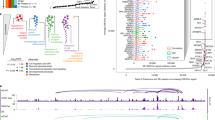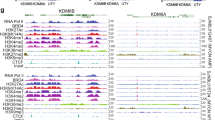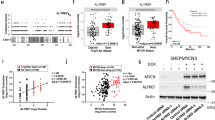Abstract
Neuroblastoma is one of the most common solid tumors in childhood. With the aim of developing a targeting vector for neuroblastoma, we cloned and characterized an enhancer in the 5′-flanking regions of the MASH1 gene by a random-trap method from a 36 kb cosmid DNA. The enhancer-containing clone was identified by the expression of GFP when transfected into neuroblastoma cell lines. The enhancer-luciferase activity is higher in neuroblastoma cell lines, IMR32, BE2 and SH-SY5Y, compared with those in non-neuroblastoma cell lines, U1242 glioma, N417 small cell lung cancer and EOMA hemangioma. The core enhancer was determined within a 0.2 kb fragment, yielding three- to fourfold higher activity than that of the MASH1 promoter alone in IMR32 and BE2. This area possesses GATA- and CREB-binding sites, as well as the E-box. EMSA on this area demonstrated that CREB/ATF could bind the DNA. Chromatin immunoprecipitation assay revealed that N-myc, CREB, and co-activators CBP and PCAF, but not HDAC1, are bound to the core enhancer at the same time as the co-activators and N-myc bind to the promoter. This supports the idea that the commonly overexpressed genes HASH1 and N-myc are regulated in concert, confirming their importance as prognostic markers or targets for therapy.
This is a preview of subscription content, access via your institution
Access options
Subscribe to this journal
Receive 12 print issues and online access
$259.00 per year
only $21.58 per issue
Buy this article
- Purchase on Springer Link
- Instant access to full article PDF
Prices may be subject to local taxes which are calculated during checkout







Similar content being viewed by others
Accession codes
References
Guillemot F, Joyner AL . Dynamic expression of the murine Achaete-Scute homologue Mash-1 in the developing nervous system. Mech Dev 1993; 42: 171–175.
Ma Q, Kintner C, Anderson DJ . Identification of neurogenin, a vertebrate neuronal determination gene. Cell 1996; 87: 43–52.
Johnson JE, Birren SJ, Anderson DJ . Two rat homologues of Drosophila achaete-scute specifically expressed in neuronal precursors. Nature 1990; 346: 858–861.
Anderson DJ . Stem cells and transcription factors in the development of the mammalian neural crest. FASEB J 1994; 8: 707–713.
Guillemot F, Lo LC, Johnson JE, Auerbach A, Anderson DJ, Joyner AL . Mammalian achaete-scute homolog 1 is required for the early development of olfactory and autonomic neurons. Cell 1993; 75: 463–476.
Huber K, Bruhl B, Guillemot F, Olson EN, Ernsberger U, Unsicker K . Development of chromaffin cells depends on MASH1 function. Development 2002; 129: 4729–4738.
Verma-Kurvari S, Savage T, Gowan K, Johnson JE . Lineage-specific regulation of the neural differentiation gene MASH1. Dev Biol 1996; 180: 605–617.
Gestblom C, Grynfeld A, Ora I, Ortoft E, Larsson C, Axelson H et al. The basic helix-loop-helix transcription factor dHAND, a marker gene for the developing human sympathetic nervous system, is expressed in both high- and low-stage neuroblastomas. Lab Invest 1999; 79: 67–79.
Arvidsson Y, Sumantran V, Watt F, Uramoto H, Funa K . Neuroblastoma-specific cytotoxicity mediated by the Mash1-promoter and E. coli purine nucleoside phosphorylase. Pediatric Blood Cancer 2005; 44: 77–84.
Akyurek LM, Yang ZY, Aoki K, San H, Nabel GJ, Parmacek MS et al. SM22alpha promoter targets gene expression to vascular smooth muscle cells in vitro and in vivo. Mol Med 2000; 6: 983–991.
Watt F, Martorana A, Brookes DE, Ho T, Kingsley E, O'Keefe DS et al. A tissue-specific enhancer of the prostate-specific membrane antigen gene, FOLH1. Genomics 2001; 73: 243–254.
Johnson JE, Birren SJ, Saito T, Anderson DJ . DNA binding and transcriptional regulatory activity of mammalian achaete-scute homologous (MASH) proteins revealed by interaction with a muscle-specific enhancer. Proc Natl Acad Sci USA 1992; 89: 3596–3600.
Izumi H, Molander C, Penn LZ, Ishisaki A, Kohno K, Funa K . Mechanism for the transcriptional repression by c-Myc on PDGF beta-receptor. J Cell Sci 2001; 114: 1533–1544.
Uramoto H, Wetterskog D, Hackzell A, Matsumoto Y, Funa K . p73 competes with co-activators and recruits histone deacetylase to NF-Y in the repression of PDGF beta-receptor. J Cell Sci 2004; 117: 5323–5331.
Mahmoudi T, Katsani KR, Verrijzer CP . GAGA can mediate enhancer function in trans by linking two separate DNA molecules. EMBO J 2002; 21: 1775–1781.
Kato H, Okamura K, Kurosawa Y, Kishikawa T, Hashimoto K . Characterization of DNA rearrangements of N-myc gene amplification in three neuroblastoma cell lines by pulsed-field gel electrophoresis. FEBS Lett 1989; 250: 529–535.
Ichimiya S, Nimura Y, Seki N, Ozaki T, Nagase T, Nakagawara A . Downregulation of hASH1 is associated with the retinoic acid-induced differentiation of human neuroblastoma cell lines. Med Pediatr Oncol 2001; 36: 132–134.
Soderholm H, Ortoft E, Johansson I, Ljungberg J, Larsson C, Axelson H et al. Human achaete-scute homologue 1 (HASH-1) is downregulated in differentiating neuroblastoma cells. Biochem Biophys Res Commun 1999; 256: 557–563.
Chen H, Biel MA, Borges MW, Thiagalingam A, Nelkin BD, Baylin SB et al. Tissue-specific expression of human achaete-scute homologue-1 in neuroendocrine tumors: transcriptional regulation by dual inhibitory regions. Cell Growth Differ 1997; 8: 677.
Ball DW, Azzoli CG, Baylin SB, Chi D, Dou S, Donis-Keller H et al. Identification of a human achaete-scute homolog highly expressed in neuroendocrine tumors. Proc Natl Acad Sci USA 1993; 90: 5648–5652.
Borges M, Linnoila RI, van de Velde HJ, Chen H, Nelkin BD, Mabry M et al. An achaete-scute homologue essential for neuroendocrine differentiation in the lung. Nature 1997; 386: 852–855.
Meredith A, Johnson JE . Negative autoregulation of Mash1 expression in CNS development. Dev Biol 2000; 222: 336–346.
Sasai Y, Kageyama R, Tagawa Y, Shigemoto R, Nakanishi S . Two mammalian helix-loop-helix factors structurally related to Drosophila hairy and Enhancer of split. Genes Dev 1992; 6: 2620–2634.
Ju BG, Solum D, Song EJ, Lee KJ, Rose DW, Glass CK et al. Activating the PARP-1 sensor component of the groucho/TLE1 corepressor complex mediates a CaMKinase IIdelta-dependent neurogenic gene activation pathway. Cell 2004; 119: 815–829.
Carlezon Jr WA, Duman RS, Nestler EJ . The many faces of CREB. Trends Neurosci 2005; 28: 436–445.
Zaman K, Ryu H, Hall D, O'Donovan K, Lin KI, Miller MP et al. Protection from oxidative stress-induced apoptosis in cortical neuronal cultures by iron chelators is associated with enhanced DNA binding of hypoxia-inducible factor-1 and ATF-1/CREB and increased expression of glycolytic enzymes, p21(waf1/cip1), and erythropoietin. J Neurosci 1999; 19: 9821–9830.
Blackwell TK, Huang J, Ma A, Kretzner L, Alt FW, Eisenman RN et al. Binding of myc proteins to canonical and noncanonical DNA sequences. Mol Cell Biol 1993; 13: 5216–5224.
Brenner C, Deplus R, Didelot C, Loriot A, Vire E, De Smet C et al. Myc represses transcription through recruitment of DNA methyltransferase corepressor. EMBO J 2005; 24: 336–346.
Brodeur GM . Molecular pathology of human neuroblastomas. Semin Diagn Pathol 1994; 11: 118–125.
Yazawa T, Ito T, Kamma H, Suzuki T, Okudela K, Hayashi H et al. Complicated mechanisms of class II transactivator transcription deficiency in small cell lung cancer and neuroblastoma. Am J Pathol 2002; 161: 291–300.
Acknowledgements
We are grateful to Dr J Johnson for the McosI cosmid and her valuable comment on the manuscript, as well as to Drs O Nilsson, S Påhlman, RA Reisfeld, L Welsh, and B Westermark for cell lines. We thank K Björklund and T Olsson for excellent technical assistance. This work was supported by grants from the Swedish Science Council, the Swedish Cancer Society, the Swedish Children's Cancer Society, STINT, the Swedish Institute, the Hjalmar Svensson Fund, and the Medical Faculty at Göteborg University. FW was partly supported by the Swedish Institute.
Author information
Authors and Affiliations
Corresponding author
Rights and permissions
About this article
Cite this article
Watt, F., Watanabe, R., Yang, W. et al. A novel MASH1 enhancer with N-myc and CREB-binding sites is active in neuroblastoma. Cancer Gene Ther 14, 287–296 (2007). https://doi.org/10.1038/sj.cgt.7701012
Received:
Revised:
Accepted:
Published:
Issue Date:
DOI: https://doi.org/10.1038/sj.cgt.7701012
Keywords
This article is cited by
-
Thalidomide potentiates etoposide-induced apoptosis in murine neuroblastoma through suppression of NF-κB activation
Pediatric Surgery International (2018)
-
MYCN induces neuroblastoma in primary neural crest cells
Oncogene (2017)
-
LIM-domain-only proteins in cancer
Nature Reviews Cancer (2013)
-
A chimeric fusion of the hASH1 and EZH2 promoters mediates high and specific reporter and suicide gene expression and cytotoxicity in small cell lung cancer cells
Cancer Gene Therapy (2008)



